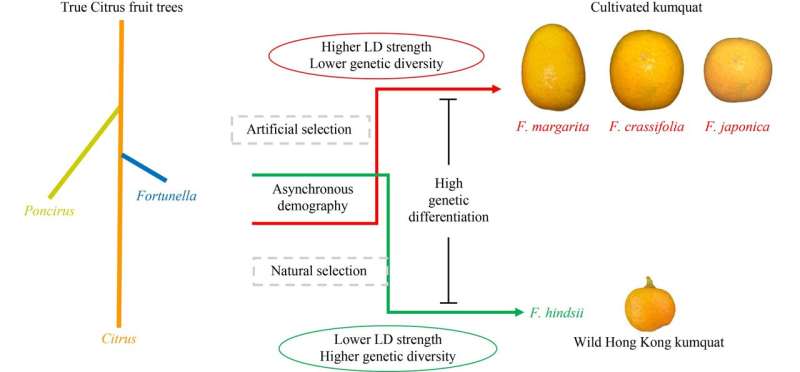Credit: Chenqiao Zhu et al, Frontiers of Agricultural Science and Engineering (2022)
Kumquat (Fortunella spp.), a common fruit crop and ornamental tree, is characterized by small, flavorful, and brilliant orange-like fruit. The cultivated Fortunella species (F. margarita, F. crassifolia, and F. japonica) is known to be originated from China, and was introduced to Europe for the first time by English botanist Robert Fortune during the Daoguang period of China's Qing Dynasty. The wild Hong Kong kumquat (F. hindsii) is widely distributed in southern China, and it has been developed as a model material for citrus gene function research due to its dwarfness, short juvenility, and monoembryony characteristics.
However, a question on this fruit species has perplexed western (Walter T. Swingle, 1871–1952) and eastern (Tyôzaburô Tanaka, 1885–1976) scholars for the past century: What is the phylogenetic relationship between cultivated Fortunella species and the only existing wild species in this genus, F. hindsii? Is the cultivated Fortunella species directly domesticated from F. hindsii or is its origin implicated with F. hindsii?
To answer these questions, Prof. Xiuxin Deng and his team have systematically collected the representative cultivated Fortunella accessions and wild F. hindsii samples from all over China in the past 10 years. By using nuclear SSR, chloroplast SNP, and genomic SNP, the genetic diversity of Fortunella genus was comprehensively evaluated, and the evolution history of Fortunella genus was traced.
The genetic analysis clearly showed the independent phylogeny of Fortunella genus among citrus taxa, which rejected the hybridization origin hypothesis of Fortunella. In addition, the Fortunella genus exhibited an obvious genetic structure and high genetic differentiation into the two major populations of cultivated Fortunella population and wild F. hindsii population. Genomic analysis showed that both the populations underwent directional selection during their evolutionary trajectory. The asynchronous population dynamics of Fortunella population and wild F. hindsii population during the Quaternary glacial period (QGP) was earlier than the human activity in southern China, and the limited domestication signals of these two populations were weakly associated with their phenotype difference together, implying that the cultivated Fortunella species may not be directly domesticated from wild F. hindsii.
Based on the results of this study and a previous phylogeographic report, Deng and his team raised a novel evolutionary hypothesis for the Fortunella genus. After differentiation from the Citrus genus, the ancestor of Fortunella evolved into an independent lineage that was widely distributed in central and southern China. Along with the progression of QGP, the northern (the ancestor of cultivated Fortunella) and southern populations (the ancestor of F. hindsii) were gradually genetically isolated from each other.
The northern population was confronted with earlier and more severe natural selection, thus experiencing an earlier population decline, eventually resulting in adaptive evolution such as a thickened peel with the enrichment of sugar and secondary metabolites to protect the seeds from freezing. The southern population encountered moderate and later natural selection, and thus maintaining the primitive phenotype. Along with the southward migration of humans, a few individuals of the northern population were occasionally selected and then cultivated, and thus they survived until now, known as Nagami (F. margarita), Meiwa (F. crassifolia), and Marumi (F. japonica). The southern population mainly underwent continuous natural selection and was discovered successively by ancient Chinese horticulturalists and modern western scholars, and they were named as "Shan Jin'gan" in Chinese and "Hong Kong kumquat" in English, respectively.
This study provides useful information for both breeding and conservation of Fortunella. The evolutionary hypothesis also provides a new perspective for profound research on the phylogeny of this genus, which still calls for more solid evidences such as related fossil evidence, and more advanced methods such as pan-genome analysis. This study is published in the journal Frontiers of Agricultural Science and Engineering.
More information: Chenqiao Zhu et al, New insights into the phylogeny and speciation of kumquat (fortunella spp.) based on chloroplast snp, nuclear ssr and whole-genome sequencing, Frontiers of Agricultural Science and Engineering (2022). DOI: 10.15302/J-FASE-2021436
Provided by Higher Education Press
























